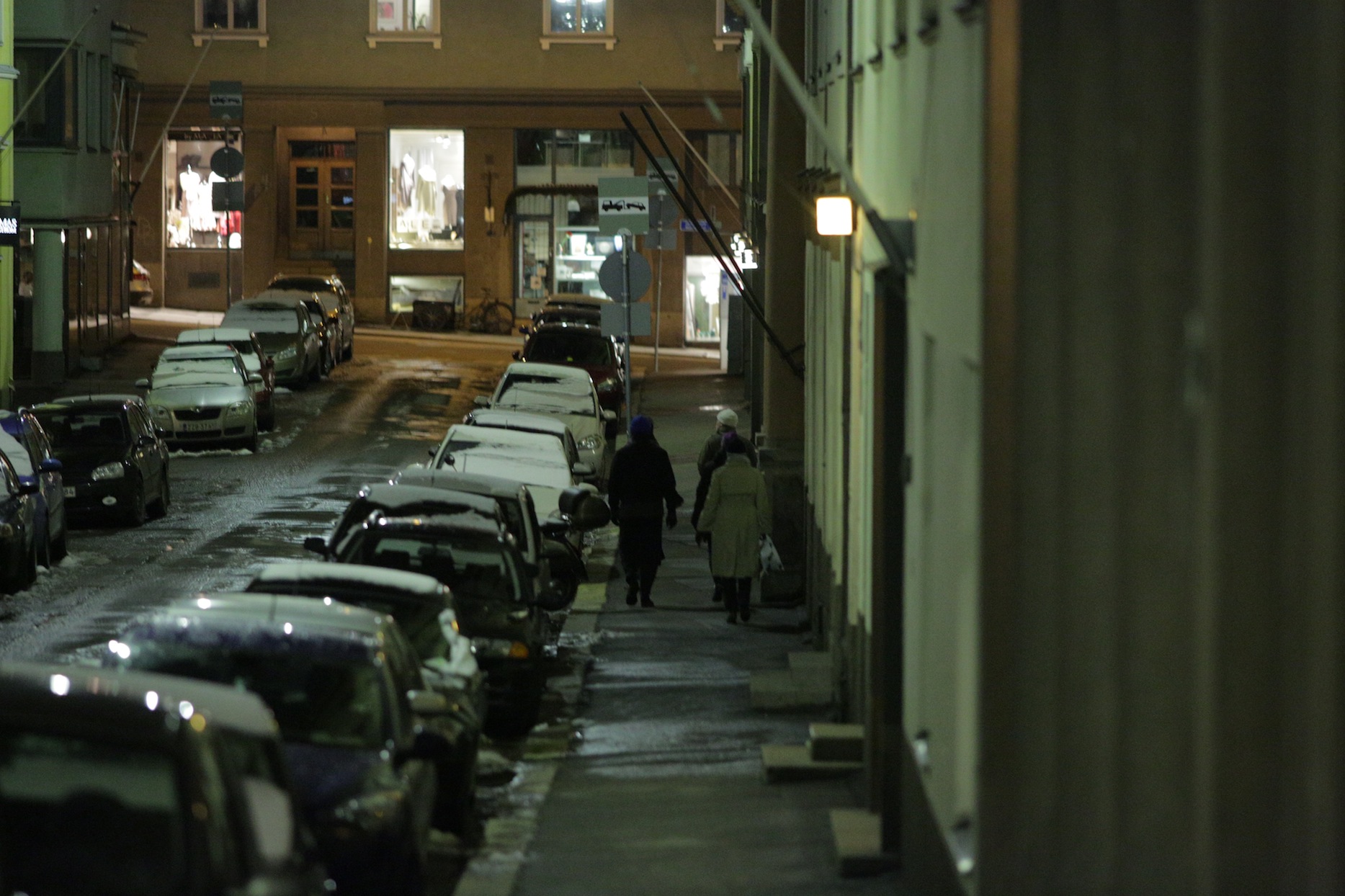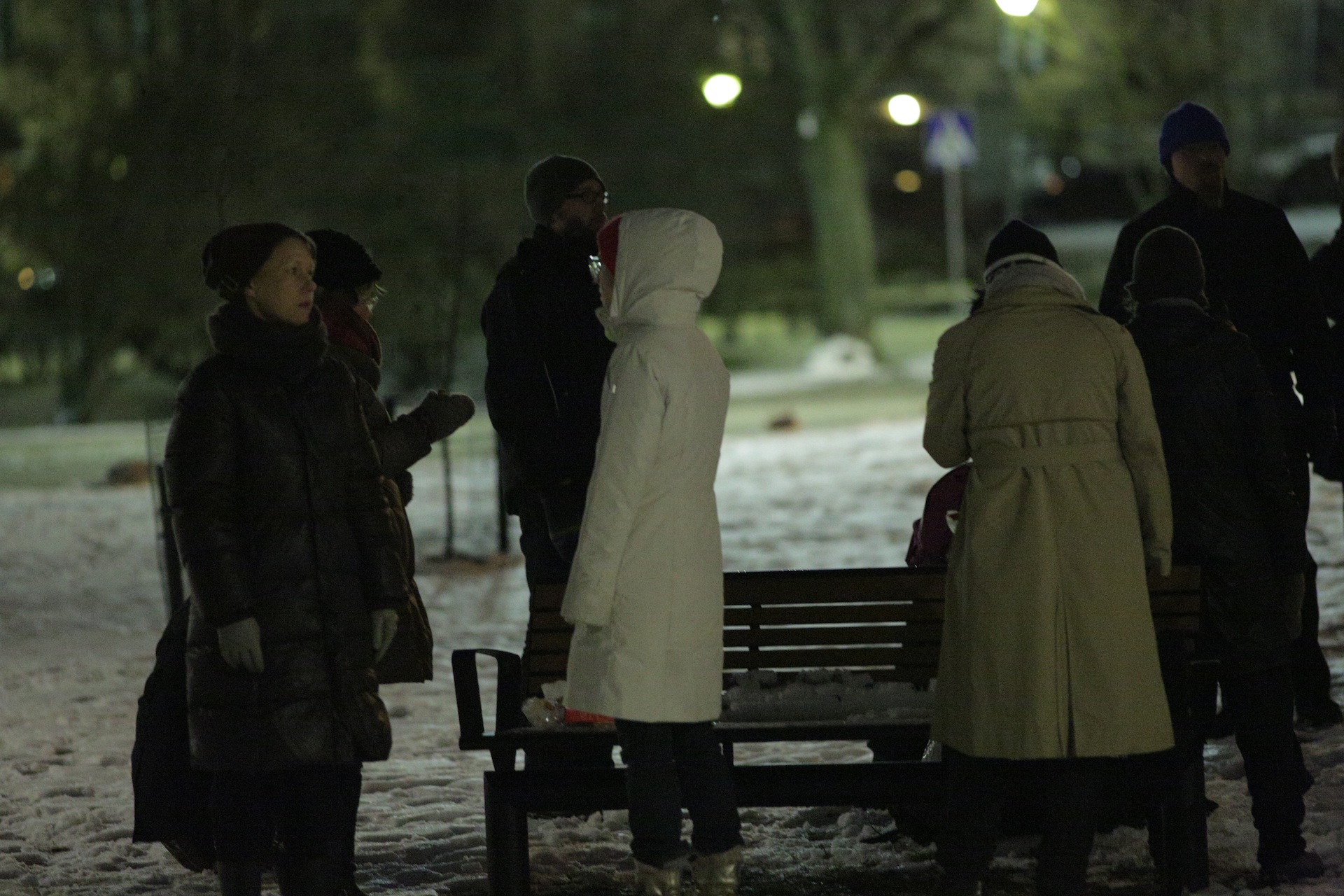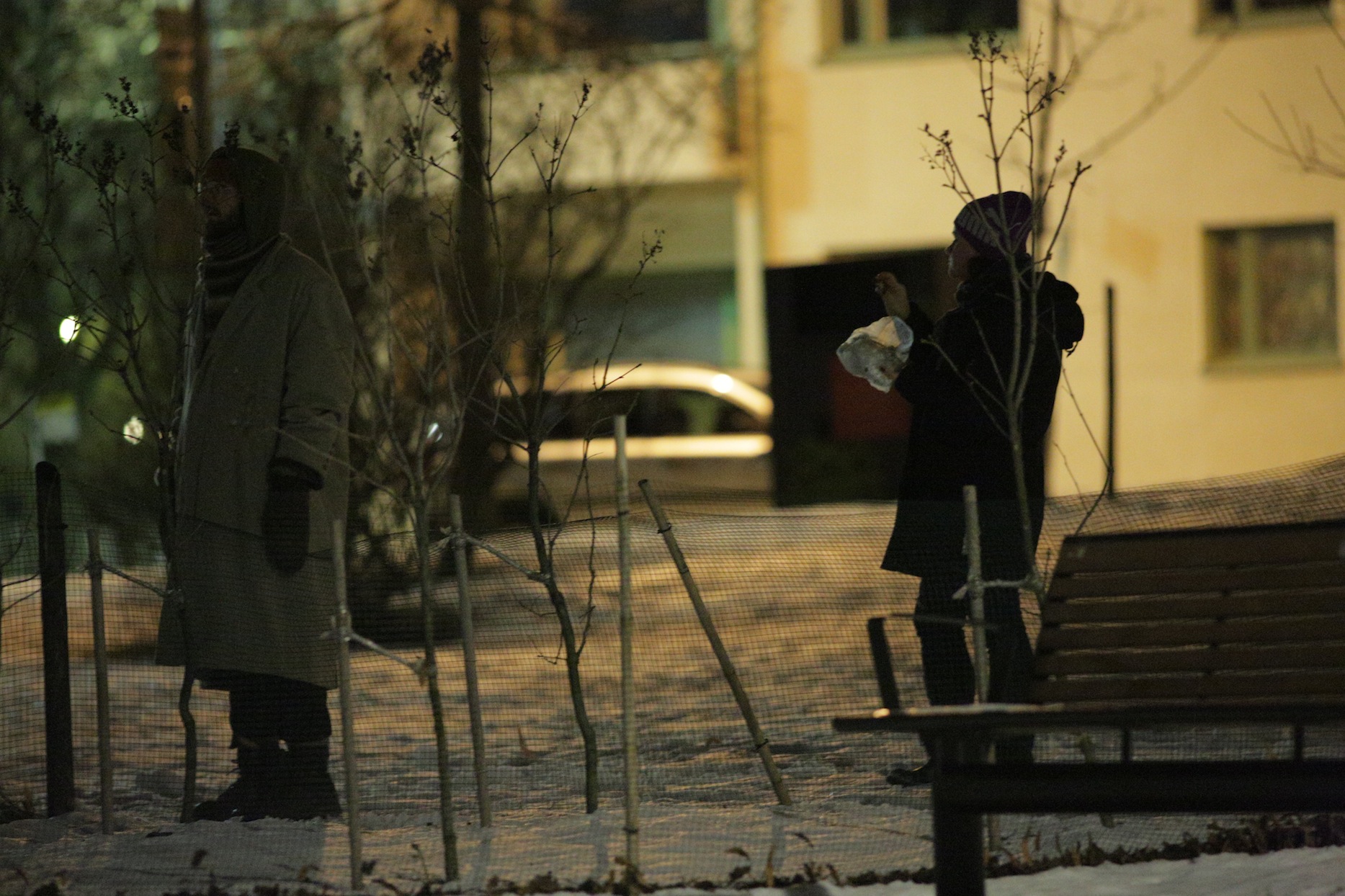Text: Jenna Jauhiainen
Pictures: Jaakko Ruuska
Three weeks ago on a Saturday evening I experienced The Wolf Safari, a participatory wandering performance created by the Other Spaces -collective (Toisissa Tiloissa). The performance left a good trail online [1] during the first weeks of March, and also during the actual wandering on the 15th.
Before attending the Wolf Safari we the participants had learned about wolves and their behavior online. The practical training for the wandering took place in the premises of Höyhentämö [2], a home for performing artists across the street from St. John’s Church. Our wolf pack consisted of about fifteen members, and the training we needed took about 1,5 hours before the actual wandering. We learned ways to communicate with each others without using words, and were told the structure of the wandering.

On my personal experience the training session was very well conducted, especially considering it was done both in finnish and english. Different members of Other Spaces described different aspects of being a wolf – how to greet members of your pack, how to warn them of dangers, and how and why to howl. The wandering itself was structured into parts. First, a solitary period of getting to know the territory of the pack. The second part was the only event tied to a specific time. Every wandering wolf was given a map of the territory with an individual marked location where to begin howling 11PM sharp, with the purpose of finding the other wandering wolves.
After the pack was to be together, we were to find a quite place and play. Apparently wolves occasionally play hunt in order to amass hunting spirit. They choose one amongst themselves to play game, over and over again in playful terms until the actual hunt begins.
The hunt itself was to happen somewhere within our territory. The “elk” we were to cartch would be leaving chalk marks on the streets while carrying a backpack filled with foods we the participants had brought for ourselves. After catching the elk, we would take the backpack to a quiet place to enjoy a shared feast. As the pinnacle and the end of the wandering, we were to find ourselves howling to the (not coincidentally, I believe) full moon by the sea at midnight.
THE WANDERING
What is it to be wild? The wolf can be seen as wild in a noble or dangerous way, depending on our point of view. In some people it evokes fear, in others sympathy. From the human perspective it’s an animal laden with mythology and therefore understanding the rhyme and reason of its actions is not always easy. Perhaps it is possible to find out more about wolves by trying looking at the world through their eyes, without attempting to tame them or weigh them down with human attributes?[3]
During my lone period before finding others of the pack, I took a short walk by the territory’s borders, deliberately trying to avoid seeing members of my pack before we were to find each others. I got a cup of takeaway coffee and sat on a bench in a children’s playground to wait for the time to hit 11PM when I was to place myself to the proximity of Bar Restroom on Tehtaankatu. Both the coffee and the playground were very unwolfy, I admit. As an analytical thinker with a conceptual mind, I needed to think myself into wolfood.
I began to construct my idea of wolves through the concept of lone wolves, which is largely a human stereotype I admit. The reason this aspect came to my mind is that as a rather extroverted person, I have lately had trouble understanding a close friend who has talked about a firm need to be alone. He has described the desire to spend hours in quiet solitude, and the angry discontent he has felt when realizing he is not alone in the forests of Helsinki – those damn strangers seem to flock everywhere! I wanted to understand both his contempt for strangers and the pleasure he seeks from solitude, and so I turned myself inward. I took as my motivation the desire to be by myself, to be of myself.

When I started walking the streets towards my meeting spot, I pushed my being into the desire for solitude that felt so rigid it began to spread waves of weird strength over my body. It wasn’t aggression or hostility, just a sense of the power I possessed in protecting my internal world, my internal being from any external influence. Like I said, I am normally a rather extroverted person. I am practically always ready to meet strangers, I like watching people and being in their presense. Usually my inscape is open, fluid and relaxed. When walking towards my howling spot, the internal lands of mine felt private and tense, and the nature of the attention I paid for my surroundings was “scanning” rather than observing.
When the clock hit 11PM, I stood behind Bar Restroom on a rock and gazed around. Even though it was a Saturday evening, very little people were around. No sight of other members of the pack. Because I felt great content in my newly discovered sense of solitude, and decided not to howl. The members of my pack felt as much strangers as anyone, and I entertained the thought of just taking a solitary walk without trying to get to the pack at all.
I walked slowly around for about ten minutes on the lot behind Bar Restroom, and then decided to continue further. I walked to Mikael Agricola’s church, and as I reached its front I began to hear distant howls. Without a hint of hesitation, I answered the howls as loud as I could, and was immediately struck by the fact that my sense of play drove over the newly discovered pleasure of rigid solitude.
What is it to be wild crossed my mind as a question as I stood listening for returning holws, and the first intuitive answer to it was being free. What I feel, and have experienced personally, is that a sense of freedom is a good ground for the birth of play. Childhood for me was a time of mostly unlimited freedom. I lived in a state of flow that turned to play even when least expected by conscientious adults. As an adult myself, the constructed wildness of the wandering was somehow a very fertile ground for a gripping sense of play. Perhaps because I had managed to drive myself to the peripheries of my normal frame of mind.
Following the howls, it didn’t take long for me to meet up with a few fellow wolve. We greeted by circling each others while revealing a side of our necks, and made slight whimpering sounds, just as taught. Without verbal communication, we orienteered ourselves by interpreting each others movements. We howled in Tehtaanpuisto as a call for others, and begun to move towards Ullanlinna.
As a wolf I was highly attentive, yet humanely conscious of my perceptios – I observed the buildings and shopwindows together with my normal frame of reference. In retrospect I think it could have been possible to play with the idea of seeing things as a wild animal in the city, yet, as I know my mind, I would have probably just gotten tangled to the process of conceptualization and the way language adds to perception. More than that, I enjoyed the sense of being in the moment, and being part of the pack.
I can’t say much about how others can use their imagination in constructing their experience. I use my imagination so often as a tool to reach “solid” conclusions about the nature of reality that I have probably grown unable to contradict reality by my beliefs, even temporarily – at least without an altered state of consciousness. This is to say, I cannot make myself take attributes of a different kind of being and live by them. I realized this when I attempted to drive myself into wolfhood. I could not separate my sense of the real from the fact that I am a human body.
A human body is a particular mammalian body, especially the female human body. Unlike most other mammals’, my biology does not time my sexuality to periods of openness and closeness. An attribute of being human is being conscious is, and consciousness defines our sexuality – my sense of sexuality lies somewhere between celibacy and nymphomania, gay and straight, all views that are processed on various levels of consciousness and paired with millions of thoughts. Rare animals can say the same.

That was a pun intended. Another rather unique aspect of both consciousness and humaness is language. We are beings of language – language defines us and our perceptions to degrees that make the mind buzz when dwelled into. Language separates objects into categories, language joins us all in communication. We can communicate amazing depths of knowledge and experience to each others, an aspect of our existence that shakes the grounds of our being with a dazzling range of emotions.
As a part of the pack I took on an independent role that I carried out throughout the wandering. I kept in my mind where the pack was while I circled the block to howl on my own in the call for others, who it took us about half an hour to find near Kaivopuisto. There, in the park, we played hunt in preparation for the actual hunt. During the hunt I ran ahead with a couple of others who clearly also experienced a rather independent drive in their wolfhood.
The hunt was exciting. It took us maybe twenty minutes to find the first chalk trail on a street between the villas of Eira, after which it took us only a few minutes to find the elk and hunt him down. Hunting game between the most prestigious estates of Helsinki was marvellous as an experience. The humanness of my wolf experience is probably most clearly revealed by the fact that as I howled in Eira, my mind associated my being to another famous wandering – that of Franks from Kallio to Eira. [4]
AFTERTHOUGHTS
After howling the full moon by the sea, we the wanderers returned back to human. An experience praised by some of the other participants, and one that I deeply shared was the pleasure of being together with people in quietness. Playing without language reminded me of how it was to play as a child with kids with which I shared no common language. When playing, language doesn’t matter. The flow does.
Eventhough my initial take on wolfhood grew from the stereotype of a lone wolf, the wandering itself gave me an experience of being a member of a pack. I truly cared about the experience others were having of the wandering, and did my best to contribute to their experience in a positive manner. This sense of community I experienced reflected the way in which wolves are dependent on the group for their survival. Unlike big cats, wolves rarely survive on their own.
Afterwards we returned to Höyhentämö and ate elk soup, a wonderful ending for the experience. Catharsis, a term often associated to experiencing the arts, had happened somewhere during the wandering. I felt energized and whole.
During the wandering, I did not feel myself as a performer. I could have included it as a part of my experience if it had crossed my mind, but it never did. If I were to lean onto the concept of being a performer, I would do it in order to relieve my mind of feelings of embarassment or doubt. I am not saying this is so for everyone. What I was looking for was an internal experience, not an external showcase.
Other Spaces did an excellent job in conducting the experience. The training was done with utmost effiency, the documentation of the wandering was barely noticeable and the way we the wanderers were brought back to normal was truly heartwarming. Next, they are providing a participatory experience of being a car/human -hybrid on a highway. The experience is done safely on a closed highway that is still under construction. [5] If interested, the registration is open until 17.4.
Others Spaces Wolf Safari Helsinki 2014 artistic work group:
Lauri Kontula, Outi Condit, Minja Mertanen, Timo Jokitalo, Jaakko Ruuska, Eeva Kemppi, Antti Halonen, Jaakko Ruuska and Anton Krylov.
With:
Esa Kirkkopelto, Kati Korosuo, Pyry Kääriä, Paula Tella, Miikka Tuominen and Sanni Priha.
References:
1 A good base to explore the online trail is this page.
2 Höyhentämö’s website
3 This quote is from the introduction to Wolf Safari
4 This is a reference to Aki Kaurismäki’s 1984 film Calamari Union.
5 More information about Moottoritie on meidän! -performance can be found in finnish from here.